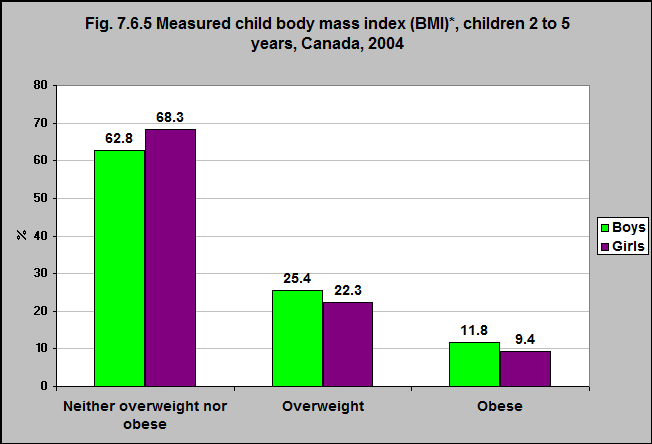Measured child body mass index (BMI), children 2 to 5 years, Canada, 2004

*Body mass index (BMI) is calculated by dividing the respondent’s body weight (in kilograms) by their height (in metres) squared. The index is: neither overweight nor obese; overweight; obese. Body mass index (BMI) for children is different from that of adults as they are still maturing. This variable classifies the measured BMI of children aged 2 to 17 as “obese” or “overweight” according to the age-and-sex-specific BMI cut-off points as defined by the WHO. Based on the WHO growth curves, the WHO recommends that children whose BMI is more than two standard deviations (SDs) above the mean should be considered obese, and those whose BMI is between one and two SDs above the mean, overweight.1
Source: CICH graphic created using data adapted from Shields and Tremblay. 2010. Canadian childhood obesity estimates based on WHO, IOTF and CDC cut-points. International Journal of Pediatric Obesity, 5: 265–273. http://www.obesitynetwork.ca/files/WHO_vs_CDC_Shields1704.pdf – accessed June 25, 2017.
Additional information on measured child body mass index (BMI) for children aged 2 to 5 years of age can be found in the Environmental Risks/Conditions section of the Early Child Development Module.
In 2004, 62.8% of boys 2 to 5 years and 68.3% of girls were neither overweight or obese.
25.4% of boys were overweight, 11.8% were obese.
22.3% of girls were overweight, 9.4% were obese.
1Shields and Tremblay. 2010. Canadian childhood obesity estimates based on WHO, IOTF and CDC cut-points. International Journal of Pediatric Obesity, 5: 265–273. http://www.obesitynetwork.ca/files/WHO_vs_CDC_Shields1704.pdf– accessed June 25, 2017.
Implications
Children who are obese are more likely to have high blood pressure and high cholesterol – which puts them at risk for heart disease. They are more likely to have type 2 diabetes, asthma, joint problems and some gastrointestinal problems. Furthermore, being obese is also linked with low self-esteem, anxiety, depression, stigma and bullying.2
Children who are obese are at risk of premature death and disability in adulthood. They are more likely to be obese as adults and to develop diseases like diabetes and cardiovascular disease at a young age.1
2Centres for Disease Control and Prevention (CDC). Childhood Obesity Causes and Consequences. https://www.cdc.gov/obesity/childhood/causes.html -accessed June 20, 2017.
3WHO. Why does childhood overweight and obesity matter?
http://www.who.int/dietphysicalactivity/childhood_consequences/en/ -accessed June 20, 2017.
